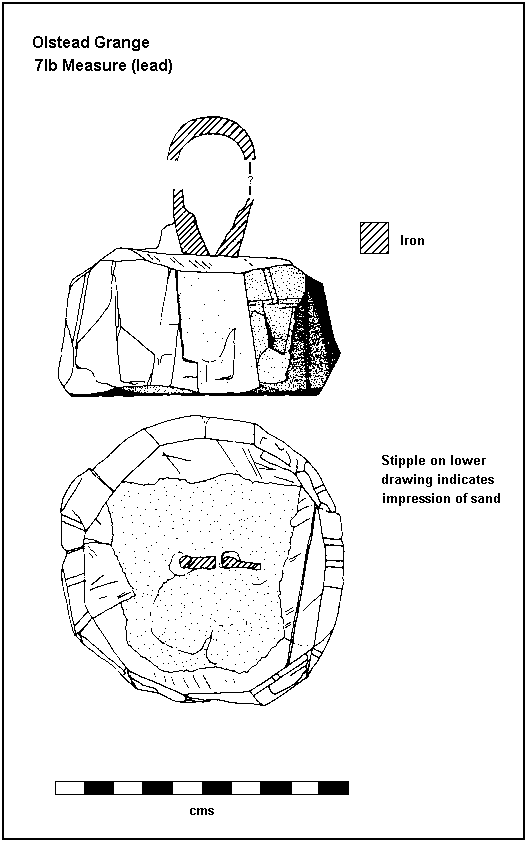
Figure 13: Lead measure
A total number of 165 sherds were recovered from stratified and unstratified contexts. The pots were very fragmented and the unstratified sherds were very worn as a result of disturbance and redeposition. No sherds are illustrated. A minimum number of 13 vessels was found in the stratified contexts associated with the structure. The minimum vessel estimate for the entire site assemblage was 40.
The pottery strongly supports the documentary dating evidence for the main period of activity on the site. The bulk of the pottery is Brandsby-type ware, a fabric of local but unprovenanced origin, predominantly in production from the mid 13th to the mid 14th century (Brooks 1987). A few sherds of Gritty ware and Yorkshire Red ware also dating to the 13th and the 13th-14th centuries, respectively, were found in the unstratified deposits.
Evidence for activity continuing into the 15th and 16th centuries is provided by stratified Humber-type ware, a Martincamp flask and Cistercian ware sherds, found within the structure and from the unstratified field collections.
The lead artefacts are the most abundant class of finds and one of the most interesting aspects of the site. There were 118 items of lead weighing in total 10.5kg (22lbs). Fifty-five of the lead items are thought to be net weights whilst the remainder appear to be scrap metal collected for re-use. The subcircular and cylindrical weights fall into two distinct types on the basis of manufacture, weight and measurement of internal diameter.
Type one weights (see figure 6) are the heavier of the two types, the largest (SF 42) weighing 430g (nearly 1lb). These weights are further sub-divided. Type 1a (e.g. figure 7) are cylindrical in shape and show no join. They appear to have been permanent fixtures on the net. Type 1b (e.g. figure 8) weights are 'quoit-shaped' and a join is visible. It seems likely that these weights can be moved or removed as required.
Type 1a weights (e.g. SFs 10 and 107) both have internal diameters of 13mm, suggesting that this was the thickness of the side ropes of the nets to which they were clamped. There is no evidence for the way these weights were manufactured. Type 1b weights (of which there are 11 examples) are mostly made from semi-circular section lead bar, which is formed into a ring with the flat side of the bar facing inwards. Variations within this type use rectangular section bar (SFs 9 and 89). The internal sub-circular diameter of the net weights is between 15 and 25mm in diameter. The approximate uniformity of the type 1 internal diameters suggest the use of a standard gauge of rope.
Type 2 weights (see figure 9) are tubular in shape and appear to be made by rolling thin lead sheet directly round the net edge rope. This method of fastening would make the weights easy to remove. Forty-two examples were recognised. Their internal diameters averaged a constant 3mm, though considerable variation was recorded in their length.
It is suggested that the heavier type 1 weights were attached to seine-nets whilst the lighter type 2 weights are from hand nets (McDonnell 1981, 30). An illustration that appears to show such weights on nets in operation is seen in the illustration reproduced opposite the title page in McDonnell (1981).
A large quantity of fragmented lead was collected from the excavations. The pieces were obviously scrap, salvaged from discarded water pipes, window kames, masonry plugs and similar fragments. It may be that some of this material was initially used at Byland Abbey and was transported to Oldstead Grange with the intention of melting for re-use. Lead droplets found around the hearth area suggest this activity.
One of the most interesting objects from the site was found near the structure by local antiquarians using metal detectors. The object (SF 41) is a large lead block with part of an iron ring firmly attached to the top.

Figure 13: Lead measure
The block of lead has been cast in a sand mould, and traces of sand still adhere to the area around the ring. After casting, the block's sides were pared down using a chisel, or similar tool, with a 24mm (c. 1 inch) blade. The block was shaped evenly to taper in towards the top but also to remain sub-circular. After rough paring, a much finer tool with a blade of about 2.5mm was used to shave even slices from around the block. This is interpreted as the final fine calibration of the measure. The weight of the object is 3.154kg (6lbs 14ozs). Taking into account the fact that part of the iron ring has corroded, the object probably weighed exactly 7lbs when originally completed.
This calibrated measure points to another activity on the site connected with the accurate weighing of the fish or fish by-products; trade or exchange may have been taking place.
The rest of the finds from the site were of iron. Most of these were nails, although two iron knife blades and a lozenge-shaped door stud were found. Although no bone was found on site, the low pH of the soil may account for its disappearance.
© Internet Archaeology
URL: http://intarch.ac.uk/journal/issue7/kemp/3.html
Last updated: Thu Dec 16 1999